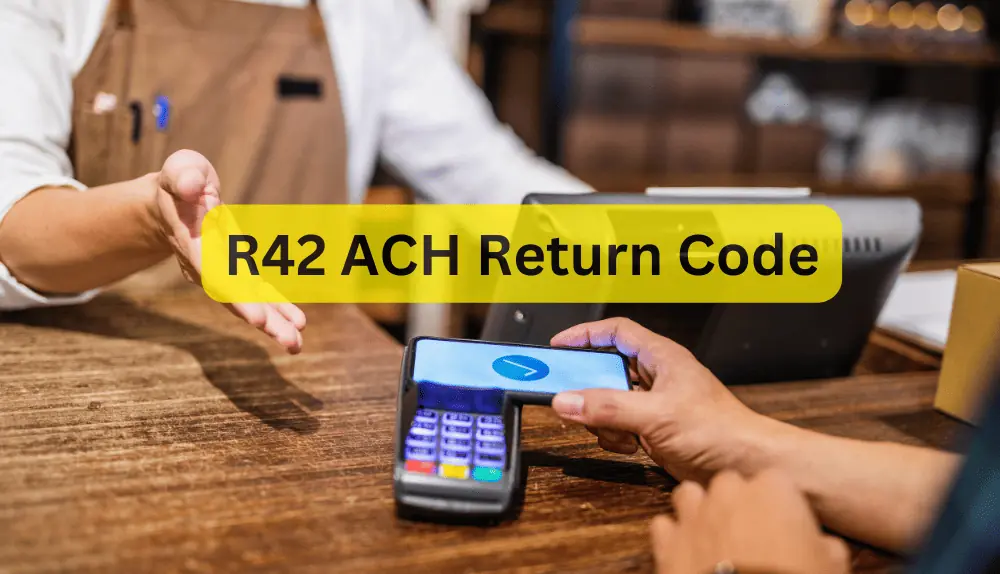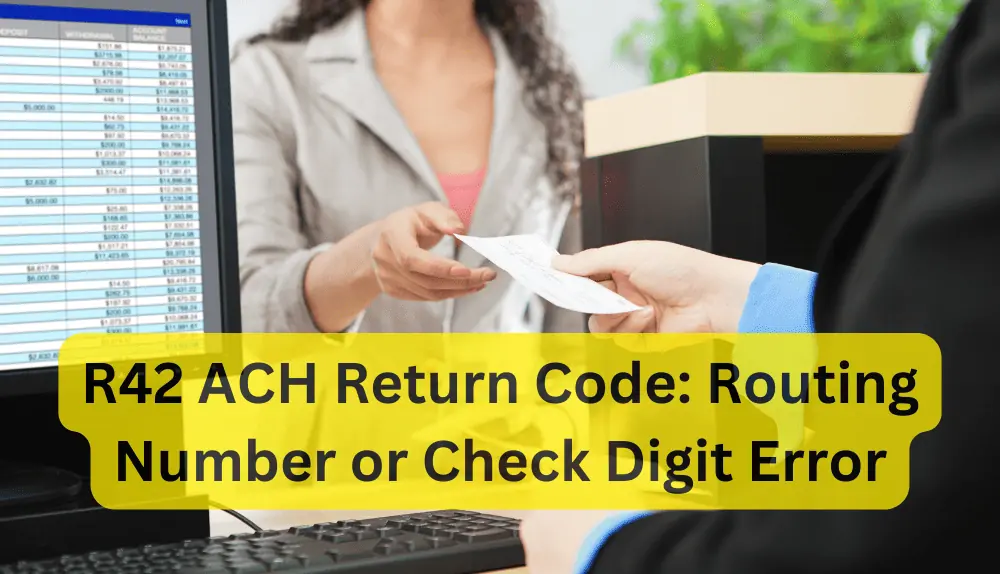For a merchant R42 ACH Return Code Routing Number or Check Digit Error is an important issue. It can be confusing if the merchant doesn’t know it’s origin and the implications. Let us understand the R42 ACH return code in-depth in this article.
What Does R42 ACH Return Code Mean?
The ACH R42 return code refers to the “Routing Number or Check Digit Error” in the Automated Clearing House (ACH) system. When a financial institution encounters a payment transaction with an incorrect or invalid routing number or check digit, it triggers the R42 return code. This code acts as a mechanism for alerting the originating institution that the ACH payment could not be processed due to the routing number or check digit discrepancy.

The implications of the ACH R42 return code can be significant for both the sending and receiving parties. For the sender, it means the intended payment has not been successfully delivered, leading to potential delays, administrative hassles, and the need for further investigation. On the recipient’s end, it can result in the non-receipt of funds, leading to operational disruptions and financial inconveniences.
Addressing ACH R42 errors requires diligence in verifying routing numbers and check digits before initiating transactions and promptly rectifying any discrepancies to ensure a smooth flow of electronic payments within the ACH network.
Reasons R42 ACH Return Code Can Occur
The ACH R42 return code, indicating a “Routing Number or Check Digit Error,” can arise due to various reasons that result in the incorrect routing number or check digit associated with an ACH transaction. Understanding these underlying causes is crucial for financial institutions and businesses to minimize the occurrence of R42 errors and ensure smooth electronic payment processing.
Data Entry Errors
One of the most common reasons for ACH R42 return codes is data entry mistakes. These errors can occur at any point during the transaction initiation process, such as when inputting the recipient’s banking information or during the setup of ACH payment instructions. Simple typographical errors, misplaced digits, or transposed numbers can lead to incorrect routing numbers or invalid check digits, triggering the R42 code.
Outdated or Inaccurate Information
Financial institutions and businesses must maintain accurate and up-to-date databases of routing numbers and check digits. Failure to do so can result in the usage of outdated or incorrect information when processing ACH payments, leading to R42 return codes. Changes in a bank’s routing number due to mergers, acquisitions, or reorganizations must be promptly updated to avoid these errors.
Routing Number Structure Changes
Routing numbers have a specific structure defined by the American Bankers Association (ABA). Changes to this structure, such as the addition or removal of digits, can occur in response to regulatory updates or industry requirements. Failure to adjust to these changes can result in invalid routing numbers, triggering the R42 return code.
Incompatible Check Digit Algorithm
ACH transactions employ a check digit algorithm to verify the accuracy of routing numbers. If the algorithm used by the sending or receiving institution is incompatible or outdated, it can result in a check digit error, leading to an ACH R42 return.
Fraud Prevention Measures
In some cases, financial institutions may intentionally trigger ACH R42 returns as a fraud prevention measure. If a transaction appears suspicious or exhibits patterns consistent with fraudulent activities, the institution may use the R42 code to halt the payment and investigate further before processing.
Steps to Fix R42 ACH Return Code
Fixing the ACH R42 return code requires a systematic approach to identify and rectify the underlying issues that caused the error. Here are the steps to resolve ACH R42 return codes:

Verify the Error
First, verify that the R42 return code indeed occurred due to a “Routing Number or Check Digit Error.” Review the ACH return message received from the receiving financial institution to confirm the specific reason for the return.
Identify the Transaction
Identify the ACH transaction associated with the R42 return code. Gather all relevant details, including the transaction amount, date, and recipient’s information, to ensure you are addressing the correct payment.
Check Data Entry
Review the data entry process thoroughly. Look for any typographical errors, misplaced digits, or transposed numbers in the routing number or check digit. Correct any mistakes found and ensure the information is accurate.
Update Information
If the R42 return code occurred due to outdated or incorrect routing number information, update the recipient’s banking details in your system with the most current and accurate data. Cross-check routing numbers against official sources to avoid future errors.
Validate Routing Number Structure
Ensure that the routing number adheres to the correct structure defined by the American Bankers Association (ABA). If any recent changes to the routing number structure have been implemented, make the necessary adjustments to comply with the new format.
Check Digit Algorithm
Verify that the check digit algorithm used by your institution is compatible with the ACH system’s requirements. If necessary, update the algorithm to ensure proper validation of routing numbers and check digits.
Review Fraud Prevention Measures
If the R42 return code was triggered as a fraud prevention measure, conduct a thorough investigation into the suspicious transaction. Implement additional security measures, if required, to prevent fraudulent activities while ensuring legitimate payments are processed smoothly.
Reinitiate the ACH Transaction
Once the issues leading to the R42 return code have been identified and resolved, reinitiate the ACH transaction with the corrected information. Before doing so, double-check all details to ensure accuracy and avoid any further errors.
Monitor and Verify
After reinitiating the transaction, closely monitor its progress to ensure it is processed successfully without encountering any additional errors or returns.
Prevent Future Occurrences
Implement measures to prevent future ACH R42 return codes. Conduct regular audits of data entry processes, update routing number databases, and stay informed about any changes to routing number structures or industry standards.
By following these steps and maintaining a diligent approach to data accuracy and security, financial institutions and businesses can effectively address and mitigate ACH R42 return code occurrences, streamlining their ACH payment processes and promoting seamless electronic fund transfers.
How Can Businesses Deal with ACH R42 Return Code
Dealing with ACH R42 return codes effectively is crucial for businesses to maintain smooth electronic payment processes and minimize disruptions. Here are some steps businesses can take to handle ACH R42 return codes:
Error Resolution and Corrections
Promptly address the specific reason for the R42 return code and correct any errors causing the issue. Thoroughly review the transaction details, including routing numbers and check digits, and verify them against trusted sources. Rectify any data entry errors and update recipient banking information as needed.
Regular Data Maintenance
Ensure that your business maintains accurate and up-to-date databases of routing numbers and related information. Stay informed about any changes in routing number structures or updates from financial institutions to avoid using outdated information that could trigger R42 returns.
Automated Verification Processes
Implement automated verification processes for ACH transactions. Utilize tools or software that can validate routing numbers and check digits before initiating payments, helping to catch potential errors in real time and preventing R42 return codes.
Communication with Recipients
In cases where the R42 return code is caused by inaccurate recipient information, promptly communicate with the recipient to obtain the correct banking details. Clear and efficient communication can help resolve discrepancies and facilitate successful ACH transactions.
Fraud Detection and Prevention
Stay vigilant for any suspicious ACH transactions and implement fraud detection measures. Regularly monitor transaction patterns and consider additional security protocols to detect and prevent fraudulent activities that might trigger R42 return codes.
Collaboration with Financial Institutions
Establish good communication with your financial institution to understand the reasons for R42 returns and work together to resolve issues efficiently. They may provide insights into recurring errors or offer guidance on handling specific situations.
Employee Training and Awareness
Train your staff involved in ACH transaction processing to be vigilant about data accuracy and potential errors. Educate them about the importance of correct routing numbers and check digits to minimize the likelihood of R42 return codes.
Regular Audits and Reviews
Conduct regular audits of your ACH payment processes to identify areas for improvement and reduce the occurrence of R42 return codes. Periodically review transaction logs and error reports to address any recurring issues.
Backup Payment Methods
Consider having backup payment methods, such as paper checks or alternative electronic payment options, available in case ACH transactions encounter R42 return codes. This can help maintain business continuity and timely payments to vendors and suppliers.
By proactively addressing ACH R42 return codes and implementing preventive measures, businesses can streamline their ACH payment processes, improve efficiency, and reduce potential financial and operational impacts caused by returned transactions.
Final Words
In conclusion, navigating the complexities of the ACH R42 return code is a critical endeavor for businesses seeking to maintain a seamless and efficient electronic payment ecosystem. As electronic transactions become increasingly prevalent in the modern financial landscape, the repercussions of routing number and check digit errors cannot be underestimated. By diligently addressing data entry accuracy, staying vigilant about routing number updates, and implementing robust verification processes, businesses can effectively mitigate the occurrence of ACH R42 return codes.
Moreover, fostering strong communication with financial institutions, emphasizing employee training, and implementing fraud prevention measures contribute to a proactive approach to handling R42 return codes. As technology and financial systems continue to evolve, businesses must remain adaptable and proactive in their strategies to keep pace with the dynamic realm of ACH transactions.
Ultimately, by consistently striving for precision and employing preventive measures, businesses can optimize their ACH payment processes, ensuring financial harmony and uninterrupted operations in an ever-connected world.
Frequently Asked Questions (FAQs)
What should businesses do when they receive an ACH R42 return code?
When a business receives an ACH R42 return code, they should promptly review the specific reason for the return, correct any errors in the transaction details, update recipient information if necessary, and reinitiate the transaction with the corrected data.
Are ACH R42 return codes reversible?
Yes, ACH R42 return codes are reversible. Once the underlying issues causing the return code are resolved, businesses can reinitiate the ACH transaction successfully.
Can ACH R42 return codes impact cash flow and financial operations?
Yes, ACH R42 return codes can impact cash flow and financial operations, especially if they result in delayed or unsuccessful payments. Timely resolution of return codes is crucial to avoid any financial disruptions.
What other ACH return codes should businesses be aware of?
There are various other ACH return codes (R01 to R99) that indicate different reasons for failed ACH transactions. These codes represent issues like insufficient funds, account closed, unauthorized transactions, etc.
Can ACH R42 return codes be prevented entirely?
While it may not be possible to prevent ACH R42 return codes entirely, businesses can significantly reduce their occurrence by implementing robust data verification processes, staying informed about routing number updates, and maintaining strong communication with financial institutions.

